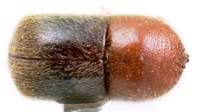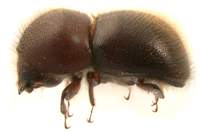Diagnosis
Medium to large, bulky, very hairy. Scutellum missing, bases of elytra costate and curved, covered with dense and long setae, associated with elytral mycangia. Antennae type 3, 4 or 5, with first segment concave or very small, less conspicuous than segment 2 and 3, antennal club often densely pubescent.
Smaller species similar to Microperus, but bulkier, antenna more pubescent, elytral puncturation confused.
Distribution
Mostly South Asia, rare in Melanesia.
Biology
Prefer (or are specific to) Dipterocarpaceae in Indonesia and continental SE Asia. Males of many species have conspicuousy enlarged and excavated pronotum with which they guards entrance tunnels of their galleries.
Taxonomy
Coptodryas formerly included many Microperus spp. (minute, with strial punctures in lines, and with slender body shape). Recently revised (Hulcr et al., 2007). Coptodryas currently reserved for large and bulky species with confused strial and interstrial puncturation, and often with abundant vestiture.
Detailed description
Eyes deeply emarginate, almost disjunct, upper part smaller than lower part. Antennal club broader than tall, club type four (segment 1 small, second and third prominent on both sides). Segment 1 of club convex, small, margin of segment 1 mostly costate, may appear softer on posterior side. Segment 2 visible on both sides of club, soft, or partly corneous on anterior side, or corneous on both sides of club. Segment 3 visible on both sides of club. Segment 1 of antennal funicle shorter than pedicel, funicle 4-segmented, scapus regularly thick. Frons above epistoma smooth, alutaceous, with minor punctures. Submentum flat, flush with genae, or slightly impressed, shaped as large triangle. Anterior edge of pronotum with two conspicuous flat serrations protruding forward. Pronotum from lateral view of basic shape (type 0), or rounded and robust (type 5). From dorsal view it is rounded (type 1), or basic, short, parallel-sided, rounded frontally (type 2). Pronotal disc shining or smoothly alutaceous, with small punctures, or with asperities resembling those on frontal slope, always with dense setae. Lateral edge of pronotum obliquely costate. Procoxae contiguous, prosternal posterocoxal process short and conical, or flat and inconspicuous. Tuft on pronotal basis associated with mesonotal mycangium absent (may be mistaken with abundant pronotal vestiture), but setae on elytral bases associated with elytral mycangium abundant and conspicuous. Scutellum not visible. Elytral bases curved, costate due to presence of elytral mycangia. Elytral disc longer than declivity and flat, or longer than declivity and convex. Punctures on elytral disc confused. Lateral profile of elytral declivity convex or very rounded, or steep, especially towards apex, or obliquely truncated. Dorsal profile of elytral apex rounded. Elytral declivity covered with dense setae, often more abundant than strial punctures, setae may be erect or appressed. Posterolateral declivital costa reduced to absent. No tubercles on declivital surface, striae and interstriae flat (some SE Asian species have more complex declivital sculpturing, including large teeth, posterolateral declivital carina, etc.). Protibiae with evenly rounded edge, posterior side of protibia flat. Protibial denticles small, bases of denticles not enlarged, protibial margin smooth and rounded, or slightly enlarged; more than 6, sometimes many more protibial denticles present. Color uniformly light brown or reddish or uniformly dark brown, pronotum sometimes much lighter than elytra. Large and robust, between 2.5 and 4.6 mm.


